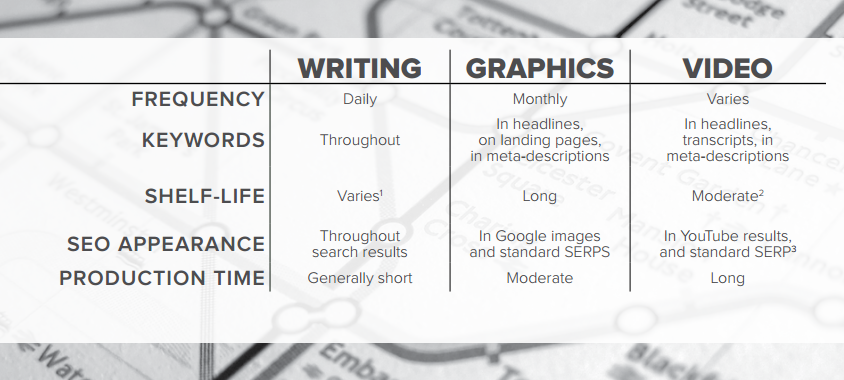In our latest eBook, “Content for SEO,” we covered how brands can optimize different types of content for search engines to drive business value. Some content will produce specific results – from lead generation to thought leadership to general web traffic – and choosing what type to create has a lot to do with the characteristics of particular audiences.
This table is a helpful way for marketers to understand what goes into the creation, publication and maintenance of three types of content – writing, graphics and videos.

But you also need to understand the benefits they provide and the goals they support. This is particularly important when planning their marketing strategies:
1. Define clear business goals (sales, increased name recognition)
2. Create web marketing goals that support these objectives (boosting web traffic, building thought leadership, generating more engagement with readers)
3. Create content to match (daily blog content, infographics, YouTube videos)
But when it comes to content for SEO, there aren’t just three options to choose from. With all these variables, brands can mix and match to create resources that are tailored to different factors. So let’s take a look at the variables and understand how to customize products, rather than choosing a one-size-fits-all option.
Show up higher in SERPs
As we’ve mentioned in the past, you don’t have to rank number one in results pages anymore to be successful with search engine optimization, and there’s still value in being as close to the top of search results pages as possible. Written content, including blog posts and site copy, offers more chances to sprinkle in relevant terms Google expects to accompany non-spammy keywords.
Be visible for extremely specific queries
Videos and graphics are often some of the highest results for very unique searches, like “How to replace an air conditioner’s air filter,” or “The best way to choose a therapist.” Focusing on making headlines and metadescriptions full of keywords and clickable text is important for non-written media.
Increase web traffic
Posting content on your site is a good strategy to get more traffic. The trouble is, some highly-sought after content types take a long time to produce, such as animated videos, white papers and in-depth infographics. To fill the gaps between these big releases and keep traffic to the site steady, you need to produce formats that don’t take as long to create, such as blog posts and video news recaps.
Wondering how content increases web traffic?
Check out this blog for more information: How often do you need to publish for effective content marketing?
But remember that SEO is a means to an end. It gets more visitors to your site, but what happens once they’re on the page? How are you nurturing those new leads and directing them through the sales funnel? Content’s power goes beyond search. Here are some goals deeper in the funnel that it can help you reach:
Goal: Build thought leadership
A lot of long-lived in-depth content will help make the argument that your business possesses better resources and knowledge than competitors. When you publish resources like white papers, ebooks, infographics, video guides and webinars every month or every quarter, you’re showing your audience that you have meaningful and worthwhile information to share.
Goal: More leads, period
Content is also the crucial part of your web marketing strategy where you tell prospects what sets you apart from others and get people to take action. The formats that tend to get the most leads require more production time, but have a longer shelf-life. To generate sales leads, content has to be valuable enough for people to hand over their contact information to see it. Longer infographics, in-depth written resources and how-to guides are some examples.
Goal: Increase the quality of leads
To generate better leads, you need to create resources that appeal to your most valuable customers. Build resources like extended blog posts, eBooks, animated videos and graphics around pain points specific to this audience. Understand that they might not get wide visibility because they’re intended for a small, but lucrative customer group.
There are marketing tools for every imaginable situation. Want to improve the quality of your leads? Try publishing weekly infographics that hold relevance for a long time. Conversely, create daily video recaps to respond to industry developments and increase SEO visibility and web traffic. Mixing and matching all of these variables might seem like a lot of work, but it’s what makes content such a scalable and customizable tool.


